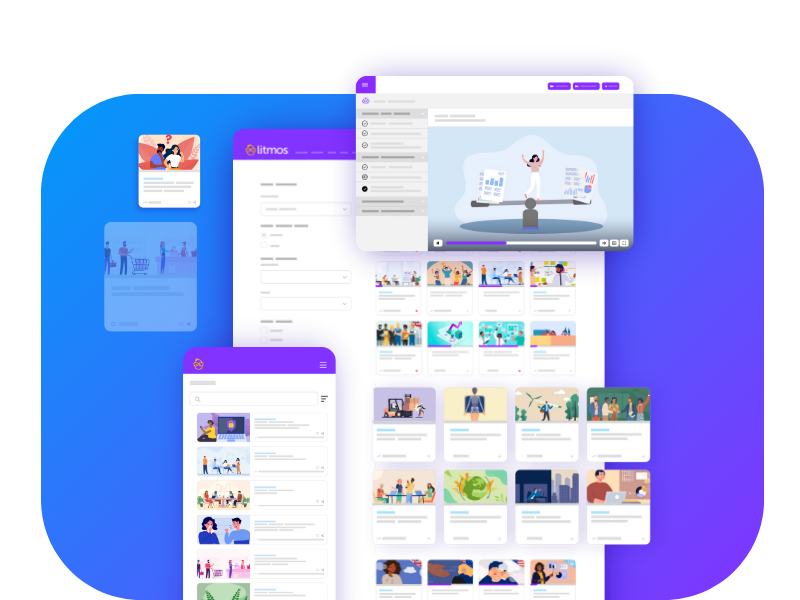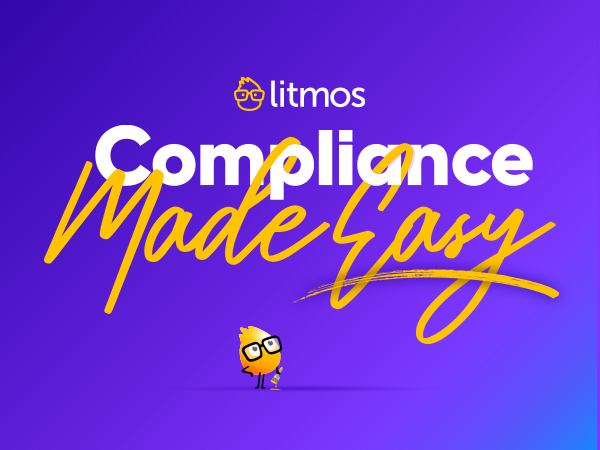10 Binge-worthy, Must-watch Learning Trends this Fall
In the Northern Hemisphere, it’s almost fall, which means that our favorite TV shows are back! Cliffhangers, romance, laughs, drama:...
This guide is your comprehensive hub for everything eLearning. Built for L&D professionals and business leaders, it goes beyond the basics to cover strategies, tools, and trends that shape modern training. From course design to platform selection and emerging innovations, use this resource to future-proof your learning strategy.
You’ll explore:

Effective learning depends on approaches that are flexible, consistent, and measurable, which is why eLearning has become central to how organizations train and grow. It goes beyond putting content online and provides a framework for designing, delivering, and scaling programs that adapt to changing needs. Many companies use learning management systems (LMS) to support these efforts, creating scalable and engaging experiences that drive both individual growth and organizational impact.
An electronic learning platform is an integrated set of interactive online services that provide trainers, learners, and administrators with the information, tools, and resources to support and enhance education delivery and management. LMS systems are one of the most common ways organizations put eLearning into practice, offering a central hub for training programs.
A wide range of companies offer online learning platforms, from systems built for employee and organizational training to virtual environments designed for hosting and selling courses as part of a business.
Understanding who benefits from eLearning starts with recognizing the different ways organizations use it to reach diverse learners and meet critical business needs. Executives in business, learning and development (L&D), and human resources (HR) often drive these strategies because eLearning supports both internal and external training.
Common eLearning use cases include:
These examples show the many ways eLearning creates value. We’ll start by exploring compliance training.
Companies need compliance training to ensure that their employees adhere to all applicable laws, regulations, standards, and internal policies. This type of training is often mandatory and can cover a wide range of topics, from workplace safety and data privacy, to industry-specific regulations. Many employers find managing, delivering, and tracking these learning programs challenging, and turn to eLearning platforms to help them streamline the process.

Traditional compliance efforts can feel reactive and resource-heavy. With the right LMS, organizations can build a better compliance training program that transforms compliance into a proactive and adaptable process.
Regardless of industry, employee onboarding plays a key role in welcoming team members into the company and equipping them for success in their roles. eLearning is the perfect tool to ensure it’s done effectively and consistently, especially for remote and hybrid workplaces. Online learning platforms enable new hires to become familiar with company culture, policies, and role-specific responsibilities at their own pace, ensuring a seamless transition into their new position. This structured approach helps employees feel prepared and confident, leading to faster productivity and higher retention rates.
A thoughtful onboarding process goes beyond orientation and sets the stage for long-term employee success. Our Continuous Onboarding Toolkit explores ways to extend learning past the first week and keep employees supported throughout their journey.
Revenue-focused teams thrive in fast-moving, competitive environments where up-to-date product knowledge and strong problem-solving skills can make the difference between hitting or missing goals. eLearning platforms deliver a flexible solution to fuel growth, with access to training anytime and anywhere, whether in the office, on the road, or in front of a client. This kind of on-demand learning ensures timely updates on new products, services, and strategies get delivered when they matter most. Effective sales training creates a level playing field, helping everyone from new recruits to veteran team members refine their approach and continue growing.
While many organizations focus training on onboarding or product launches, sales teams need ongoing development to sharpen their skills and stay ahead in a high-pressure market. Discover how to support your sales team through every stage of their career with practical approaches in the Rev Up Revenue Guide.
Customer support teams are on the front lines, shaping satisfaction and loyalty with every interaction. To deliver consistently strong experiences, agents need ongoing training on product updates, company policies, and communication best practices. eLearning makes this possible by offering standardized, on-demand modules that give team members access to the latest information, no matter their location.
Why multilingual training matters for CXDid you know companies with trained multilingual staff report average increases in customer retention of around 30%?
Selecting the right platform can make all the difference. Our Guide to Choosing a Customer Support LMS highlights how to evaluate features like global reach, multilingual delivery, and reporting tools to create a training program that grows with your team and evolves alongside customer expectations.
Investing in professional development is one of the most effective ways to retain talent and build a workforce that can adapt to change. Employees expect opportunities to advance their skills, and organizations that provide them see stronger engagement and loyalty in return. With an eLearning platform, professional development becomes more accessible through a broad mix of training, from technical certifications to soft skills, delivered in formats employees can access at their own pace.
Modern LMS solutions can support employee development with features like personalized learning paths and AI-driven self-directed learning recommendations, making it easier for employees to guide their own growth. At the same time, organizations can focus on leadership training to prepare high-potential team members for management roles.

Developing leaders internally not only reduces recruiting costs but also improves retention and helps prevent the “brain drain” that occurs when experienced employees leave without successors in place. Insights like those in the HR Playbook for Transformative Leadership show how to connect professional development with long-term business outcomes by cultivating both individual growth and organizational resilience.
Training initiatives often extend beyond internal teams to include the broader business ecosystem of partners and customers. Partners, such as resellers or distributors, are a vital extension of your sales force. Effective partner training gives them the product knowledge, brand alignment, and selling skills needed to represent your organization with confidence.
The undeniable impact of training partnersDid you know that deals close about 46% faster when a partner’s involved in the sale?
Similarly, customer training is a powerful tool for building product adoption and long-term loyalty. By giving customers the tools to get the most value from your products and services, you not only empower them to achieve better outcomes but also reduce the strain on support teams. Long story short: better customer training leads to improved satisfaction, lower support costs, and higher customer retention.
When done well, customer training becomes more than just a support function. It is a growth strategy that strengthens adoption, deepens loyalty, and contributes directly to revenue. Our Customer Training Playbook illustrates how organizations are using education to tie customer success more closely to business outcomes.
Organizations have more options than ever for how they deliver training. From structured classroom instruction to flexible online modules, each approach brings unique strengths for different goals and learner preferences. Understanding the differences helps build a learning strategy that is both effective and engaging.
There’s no single way to structure learning. These next eLearning format examples highlight how organizations adapt training to balance business goals with learner needs.
Instructor-led training (ILT) is the most traditional format, delivered in person or online with an instructor guiding learners in real time. It works best for complex subjects that require discussion, feedback, and active participation.
Most effective for:
Virtual instructor-led training adapts the classroom experience to a digital setting, combining live instruction with tools like video conferencing and virtual whiteboards. It balances the structure of ILT with the scalability and flexibility of online delivery.
Most effective for:
Asynchronous, or self-paced learning, lets employees move through training modules on their own schedule, balancing development with daily responsibilities. Typically delivered through an LMS, these courses combine videos, readings, quizzes, and interactive exercises to support flexible, repeatable learning.
Most effective for:
Microlearning delivers short, highly-focused lessons that can be completed in just minutes, making it easy to fit learning into the flow of work. From quick videos to short quizzes, this format helps reinforce key concepts, prevent overload, and support continuous skill development.
Most effective for:
How microlearning boosts productivityDid you know that learners report being 58% more likely to use their company’s LMS when they have access to microlearning modules?
Social learning creates stronger connections by encouraging learners to share knowledge, exchange feedback, and learn through interaction. Discussion forums, group projects, and peer-to-peer exchanges turn training into an organization-wide dialogue that blends skill development with community building.
Most effective for:
Blended learning combines the strengths of multiple training formats, such as instructor-led sessions and self-paced modules, to create a flexible and engaging learning journey. This approach allows organizations to tailor experiences to both the content and the audience, resulting in more effective outcomes.
Most effective for:

Gamification applies game mechanics such as points, badges, leaderboards, and challenges to learning experiences. This approach motivates learners by tapping into natural drivers like achievement, recognition, and competition, which can make training more engaging and memorable.
Most effective for:
Instructional design is the systematic process of creating engaging, effective learning experiences. In eLearning, it blends research-backed models with creative design to produce digital training that motivates learners, enhances retention, and drives measurable performance. Effective instructional design answers the learner’s question, “What’s in it for me?” while aligning with organizational goals for growth and development.
The ADDIE model (Analysis, Design, Development, Implementation, Evaluation) provides a structured yet flexible framework for creating learning programs. Its iterative nature allows L&D teams to refine content continuously, keeping training relevant and aligned with organizational needs.
Each stage plays a critical role:
This cycle keeps training dynamic, producing learning experiences that are structured yet responsive to feedback. Rather than a one-time process, ADDIE serves as a living framework that evolves as organizations grow and priorities shift.
The ARCS Model (Attention, Relevance, Confidence, Satisfaction) offers a framework for designing eLearning that motivates learners and sustains engagement. By focusing on these four elements, instructional designers can transform training into meaningful, performance-driven experiences.
Each pillar contributes to learner success:
Together, these pillars turn training into meaningful experiences that drive participation, retention, and improved performance.

Creating effective eLearning means going beyond simply delivering information. Well-designed learning content connects users to clear goals, incorporates interactive elements, and provides regular feedback that supports progress. When learners see their achievements build over time, confidence and motivation naturally increase.
Adding variety, from scenarios and role plays to quizzes and video demonstrations, helps reinforce knowledge while keeping attention high. At the same time, feedback loops ensure the course remains a two-way experience, allowing learners to reflect, apply, and grow.
The result is eLearning that is structured, engaging, and impactful. It not only teaches but also strengthens retention and drives real-world performance.
Designing and delivering effective eLearning programs isn’t without its obstacles. Every program faces moments where resources, timelines, or engagement can become barriers to success. The difference between stalled initiatives and thriving ones often comes down to how these challenges are addressed. By approaching them with focus and strategy, L&D leaders can turn potential roadblocks into opportunities for stronger outcomes.
Outlined below are common eLearning challenges paired with practical strategies to address them.
| Focus area | Challenge | Solution |
|---|---|---|
| Budget & resources | Tight budgets | Maximize your resources with royalty-free media and pre-made templates to reduce costs while keeping a professional look. |
| Design & development | Limited development time | Streamline your process with a modular design, using rapid content authoring tools to repurpose assets and development. |
| Collaboration & expertise | Inconsistent expert input | Build structure in your collaboration with SMEs through interview guides and feedback cycles to prioritize critical content. |
| Learner experience | Keeping learners engaged | Focus on the learner with simple, mobile-friendly formats and engaging scenarios to make content more compelling. |
| Strategy & alignment | Shifting operational priorities | Use a comprehensive L&D blueprint to align training with business objectives during big periods of organizational change. |
| Culture & communication | Team silos & poor communication | Break down silos and organizational chaos by fostering two-way communication and feedback loops for ongoing improvement. |
| Measurement & outcomes | Proving the ROI of training | Align learning goals with KPIs to clearly demonstrate measurable value from training programs to business outcomes. |
The future of workplace learning is being reshaped by artificial intelligence, deeper personalization, and a stronger emphasis on career growth. These trends are redefining how organizations deliver and measure their training programs.
AI has moved from futuristic theory to practice, becoming a trusted tool for assessing skill gaps, guiding workforce development, and creating adaptive learning paths. According to findings from our Shaping the Future of L&D report, the most in-demand AI capabilities in an LMS include personalized learning paths for specific roles, real-time feedback, and intelligent skill gap analysis.
This shift in learner expectations is equally significant. Employees are increasingly motivated by opportunities for career growth rather than monetary incentives, underscoring the importance of career-oriented training. To meet these demands, organizations must embrace flexible delivery methods like microlearning and mobile-first platforms that provide learning in the flow of work.
Emerging realities in workplace learningDid you know that 45% of employees reported having little to no control over their workplace training?
As workplace dynamics shift from “The Great Resignation” to “The Great Stagnation” and now “The Great Flattening“, L&D must prepare employees with both technical and durable soft skills. Giving learners greater autonomy fosters adaptability and ensures training stays relevant as business needs evolve.
The future of eLearning is a data-driven, learner-centric ecosystem where AI insights and personalization support both talent development and business growth.
Selecting the right learning management system (LMS) is a critical step in modernizing your training strategy. The best platform aligns with your organization’s goals, supports scalability, and delivers a seamless experience for both learners and administrators..
Identify training goals (onboarding, compliance, upskilling), technical requirements and learning measurement success metrics. Establish baseline needs and LMS integrations with HRIS or CRM tools for smooth workflows.
Choose an LMS with an intuitive interface that works across devices. Learners should be able to access content easily, while admins can manage users, content, and reporting with minimal effort.
Ensure your LMS has robust reporting capabilities to track learner progress, measure training effectiveness, and identify skill gaps. Look for real-time dashboards with data visualizations and export options that make it easy to share key insights with stakeholders.
The power of gamified learningDid you know that 78% of U.S. employees cited their job as being more enjoyable with gamified training?
Leveraging AI in LMS platforms helps organizations automate assignments, deliver personalized learning paths, and provide real-time feedback. This helps learners build skills faster and keeps training relevant.
Ask vendors about AI ethics and data policies to confirm your content remains secure. Verify that the LMS protects sensitive data and does not use it for public AI models.
Select a platform that scales with your business. Consider pricing, architecture, and performance under increased user loads to ensure long-term success.

Whether the goal is improving compliance, accelerating onboarding, or closing critical skills gaps, delivering personalized, adaptable learning at scale across every industry is the key to achieving your goals. By tailoring eLearning to industry-specific challenges, businesses can reduce risk, future-proof their learning strategies, and create stronger learning cultures. Discover how companies are applying modern LMS solutions to achieve measurable results.
As a customer-owned bank, P&N Bank needed a robust financial training solution to ensure its 500+ employees stayed compliant and up-to-date with regulations. With Litmos, they transitioned from a paper-heavy process to an automated system that streamlined compliance, reduced administrative overhead, and fostered a stronger culture of learning and engagement.
Key results:
Russell Mineral Equipment (RME), a global leader in mining equipment, needed a way to deliver consistent, high-quality manufacturing training to technicians and customers worldwide. By moving to a centralized LMS, RME standardized training modules across all regions, ensuring every learner received the same level of instruction and support.
Key Results:
Sabre, a global technology provider in the travel industry, needed a scalable way to train its worldwide tech workforce across diverse products and services. By creating “Sabre University,” a centralized LMS with an extensive course library, the company empowered employees to manage their own professional growth while supporting business expansion.
Key results:
SouthernCarlson, a leading distributor of construction and packaging supplies, needed a way to unify its construction training programs across 150+ locations. By centralizing and standardizing their learning with an LMS platform, the company delivered a consistent learning experience, improved compliance, and created a safer, more efficient workplace.
Key Results:
Stockport Homes, a UK-based housing organization, needed to replace its outdated LMS with a modern, mobile-friendly training solution. With Litmos, they streamlined compliance and employee development for 700+ staff, driving higher adoption and stronger course completion rates.
Key Results:

In the Northern Hemisphere, it’s almost fall, which means that our favorite TV shows are back! Cliffhangers, romance, laughs, drama:...
eLearning is often praised for its flexibility, scalability, and reach. However, behind the scenes of every sleek training module lies...
L&D professionals play an important role in fostering a culture of continuous learning within organizations. Depending on how their organization...